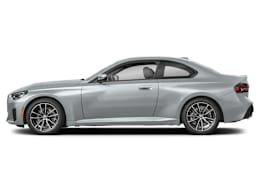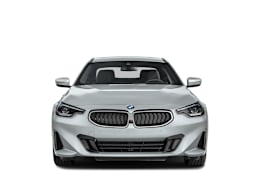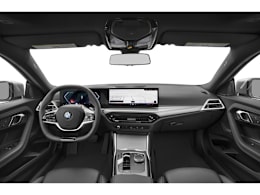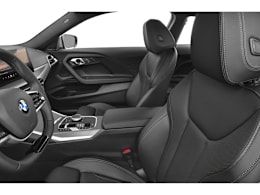The 2 Series Coupe is a thoroughbred, rear-wheel-drive-based BMW that’s a blast to drive, thanks to sharp handling and an energetic powertrain. It’s impressively fuel-efficient, too. Think of this two-door, four-seat sports coupe as a grown-up alternative to a Toyota GR86 or Volkswagen Golf GTI.
The base rear-wheel-drive 230i Coupe we tested (all-wheel drive is optional) proved a potent performer. With its 255-horsepower, 2.0-liter turbocharged four-cylinder engine teamed with an eight-speed automatic transmission, power delivery is linear and punchy from low on the tachometer all the way to redline. Some might lament that a manual transmission is no longer available, but the eight-speed automatic works impressively well, with smooth, quick upshifts and appropriately-timed downshifts. Switching the car to Sport mode makes for sharper shifts and a more invigorating engine and exhaust note. We timed the 230i Coupe at a speedy 6.4 seconds in the run from 0 to 60 mph. Fuel economy is a commendable 31 mpg overall, albeit on the required premium fuel.
Those who crave more power, or who want to experience the supreme silkiness that comes with BMW’s vaunted turbocharged inline-six engine, should consider the M240i. Also available with either rear- or all-wheel drive, the M240i pumps out a thrilling 382 hp, but it costs about $11,000 more than the 230i.
The 2 Series Coupe’s compact dimensions, along with its taut, agile, and balanced nature, makes it a fantastic companion for a spirited drive on a curvy road. The only demerit we’d give the car in the handling department is that the steering is too vague, failing to transmit as much feedback about tire grip and road texture as a proper sporting machine should. The ride is far from luxury-car-plush, as larger bumps noticeably jolt through into the cabin, but the 2 Coupe doesn’t beat you up in the manner of some sports cars.
It takes agility to get in and out of this low-slung coupe, and the long doors add to the difficulty when another vehicle is parked close to you. The center console hems the driver’s right knee in a bit, but there is perfect symmetry between the pedals and the left footrest. We found that the low seating position was more suitable for taller drivers, as they were better able to see over the relatively tall dashboard. The front seats have well-defined bolsters to hold you in place through corners, and they proved comfortable for longer journeys in spite of a lack of lumbar adjustment. The rear seat is very tight, only useful for small children or possibly adults in a pinch, due to scrunched head- and legroom, and foot space under the front seats—at least the front seats power forward electrically to clear a path.
The cabin is nicely finished with a solid, well-crafted feel, although there are some areas where the materials don’t exude the luxury of higher-priced BMWs. BMW’s latest iDrive infotainment system has lots of capability and responds quickly to inputs, but user-friendliness suffers compared to prior versions. It definitely requires some time to master the intricacies of all of the available functions. Unfortunately this latest version removes most physical climate controls and moves them into the touchscreen. Wireless Apple CarPlay and Android Auto come standard.
Forward collision warning, automatic emergency braking with pedestrian and cyclist detection, blind spot warning, rear cross traffic warning, lane departure warning, and lane keeping assistance come standard.























